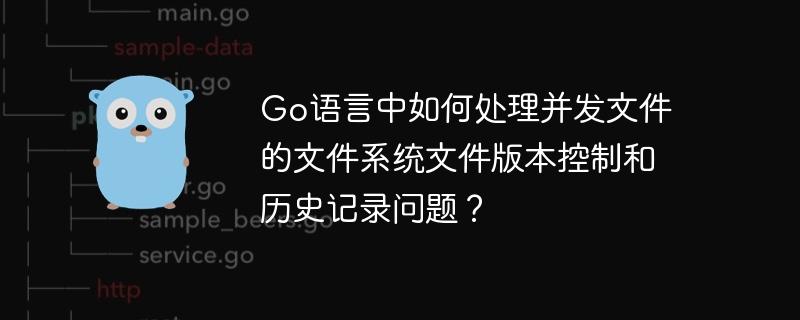

How to deal with file system file version control and history issues of concurrent files in Go language?
With the continuous advancement and iteration of software development, file modification, update, rollback and other operations have become very common. When multiple people operate on the same file at the same time, how to ensure file version control and history has become an important issue. This article will introduce how to use Go language to handle file system file version control and history issues of concurrent files, and provide specific code examples.
First, we need to define a file structure to represent the metadata and content of the file:
type File struct {
FileName string
Version int
Content string
History []string
mutex sync.Mutex
}In this structure, we add the file name, version number, content and Fields such as history records. Among them, the mutex field is used to implement a mutex lock for file operations.
Next, we define a global file mapping table to store all files:
var files = make(map[string]*File) var filesMutex sync.Mutex
In this global file mapping table, the file name is used as the key, and the file structure is The body serves as value and stores all file objects.
In order to implement file version control and history recording, we need to define some operation methods. The first is the method of creating a new file:
func CreateFile(fileName string, content string) {
filesMutex.Lock()
defer filesMutex.Unlock()
if _, ok := files[fileName]; !ok {
file := &File{
FileName: fileName,
Version: 1,
Content: content,
}
files[fileName] = file
}
}In this method, we first lock to prevent other coroutines from creating the same file at the same time. Then, determine whether the file name already exists. If it does not exist, create a new file object and add it to the file mapping table.
Next, we define the file update method:
func UpdateFile(fileName string, content string) {
filesMutex.Lock()
defer filesMutex.Unlock()
if file, ok := files[fileName]; ok {
file.mutex.Lock()
defer file.mutex.Unlock()
file.Version++
file.Content = content
file.History = append(file.History, content)
}
}In this method, we also lock first, and then determine whether the file exists. If it exists, perform a mutex lock operation on the file to prevent other coroutines from modifying it at the same time. Then, update the file's version number and content, and add the new content to the file's history.
Finally, we define the rollback method of the file:
func RollbackFile(fileName string, version int) {
filesMutex.Lock()
defer filesMutex.Unlock()
if file, ok := files[fileName]; ok {
file.mutex.Lock()
defer file.mutex.Unlock()
if version <= file.Version && version > 0 {
file.Version = version
file.Content = file.History[version-1]
}
}
}In this method, we also lock and determine whether the file exists. Then, perform a mutex lock operation on the file to prevent other coroutines from modifying it at the same time. Then, according to the specified version number, the file is rolled back to the corresponding history record, and the version number and content of the file are updated.
Through the above code examples, we can use the Go language to implement file system file version control and history recording functions for concurrent files. When multiple coroutines operate on the same file at the same time, the consistency and correctness of the file are ensured through the mutex lock mechanism. At the same time, the file version control and history recording functions can help developers track the modification history of files for easy rollback and viewing.
The above is the detailed content of How to deal with file system file version control and history issues of concurrent files in Go language?. For more information, please follow other related articles on the PHP Chinese website!




